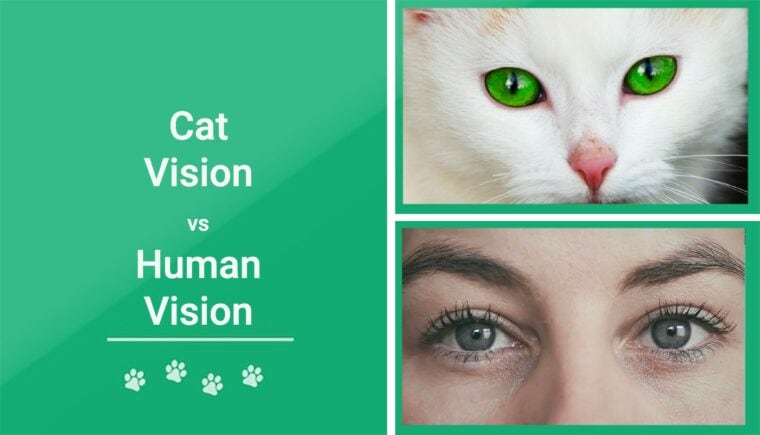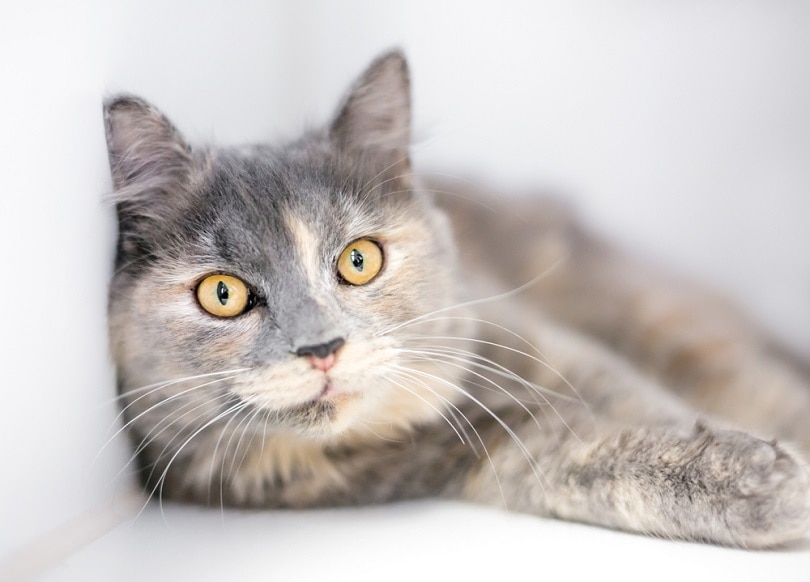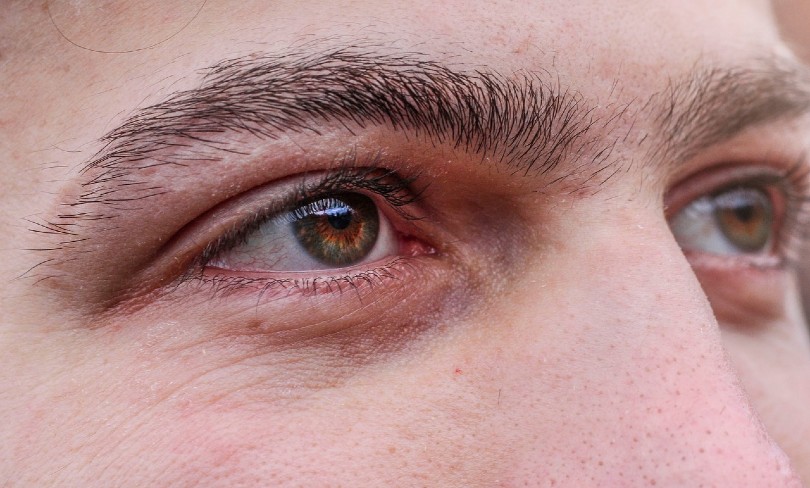
We might not always realize it, but cats and humans have very different visions. We share our lives and homes with our furry friends, but we don’t view the world around us in the same ways.
Just by looking at a cat’s eye, you can tell that it’s not the same as a human eye. There are also various differences in the actual act of sight. For example, humans don’t see well in the dark, but we have little trouble seeing different colors. Cats have much better night vision but can’t detect many colors.
Read on to learn more differences between cat and human vision.

How Do Eyes Work?
Here’s a quick summary of how eyes work before we get into how these things are different in cats and humans.
Behind the eye lies the retina. This is a thin layer of tissue that contains two main types of photoreceptors: rods and cones. These photoreceptors respond to light and turn light rays into messages for the optic nerve, which then sends these messages to the brain. The brain takes those messages and translates them into images.
Rods provide the ability to see in the dark or at low light levels. Cones help during the daytime to detect colors.
Now that we know eye basics, here are the differences between cat and human vision.
Overview of Cat Vision

Cats rely on their unique vision to help them hunt and capture prey. They don’t have the advantage of great speed, strength, or height. Therefore, their vision enables them to stalk their prey stealthily and ambush it before it even knows what’s happening.
Cat Eye Function
A cat’s eye is made up of the sclera, or the white of the eye, which is a tough, outer layer. That is covered by the conjunctiva, a thin membrane near the front part of the eye. This membrane goes to the edge of the cornea and inside of the eyelid.
The cornea is a clear dome on the front of the eye that protects it while directing light back toward the retina. The iris, the colored part of the cat’s eye, surrounds the black pupil in the center. The pupil enlarges in the dark to let in more light and retracts in brightness to let in less light.
Cat Vision
Rods are sensitive to light, and cats have a large number of rod cells. Since they have more rods than cones, they can make out shapes and movements in low-light areas.
Another reason that cats have such strong night vision is due to their mirrored eyes. A mirrored layer lies behind the retina, reflecting light. Any light that doesn’t make contact with a rod in a cat’s eye is bounced back out. This gives the light another chance to hit a rod and be used.
Does your cat stare at the wall, focused on something that you can’t see? Their mirrored eyes are the reason for this behavior. They can detect the smallest movement from dust bunnies or a tiny insect that you never would’ve noticed.
Another element that adds to their hunting ability is their peripheral vision, which is about 200 degrees.

Overview of Human Vision

Humans can see better in daylight and with bright lights. We can also see objects more clearly from great distances and see a wider range of colors than cats can.
Human Eye Function
Human eyes consist of the sclera, conjunctiva, cornea, iris, and pupil. Our eyes are structured similarly to cats’ eyes, but we have different-shaped pupils. Cats have vertical slit pupils, while humans have round ones.
The lens of the eye, located behind the pupil, directs light to the back toward the retina. The retina turns the light into electrical impulses that get carried to the brain by the optic nerve and tells us what we are looking at.
Human Vision
Humans see well in daylight because of our retinas, which have many light receptors. We can focus on something that is close and see it clearly, while a cat would need to be much farther away to get a clear image of the object.
Humans have three types of cone photoreceptors that enable us to see a wide array of colors. Our retinas have 10 times more cones than cat retinas. We can detect motion in bright lights and determine how far away objects are, which helps us do things like walk and drive.
Our peripheral vision is only about 180 degrees, compared to 200 for cats.

What Are the Differences?
Cat Vision
Cats have a greater peripheral vision range than humans, which enables them to see prey. This helps them to be proficient hunters.
Cats have better night vision than humans, which helps them during their most active hunting hours, between dusk and dawn. Cats can see six times better in low light than humans can.

Human Vision
Cats don’t have all the advantages in terms of vision. Humans have better motion detection during daylight hours. Humans can determine objects that are slowly moving — these objects may look stationary to our feline friends.
Humans are more far-sighted than cats. We can see objects from 100–200 feet away, but cats can’t see them clearly past 20 feet. The objects will start to appear blurry to them past that distance. A human’s vision can be 20/20, but a cat’s vision is more like 20/100 to 20/200.
Retinas
The biggest difference between cat and human vision is in the retina. Cats have a high number of rod receptors and a low number of cone receptors in their retinas. Humans have the opposite, which is why we have poor night vision but superior color detection.
Cats have superior night vision in comparison and can follow fast-moving objects in the dark.
Pupils
Cats and humans both have pupils, but cats have pupils shaped like vertical slits. Humans have round pupils. Slit pupils protect nocturnal animals’ sensitive eyes in the daylight. It can close as much as it needs to in order to keep light out of the eye. Humans are mostly active in the daytime, so our eyes are not as sensitive to light. Round pupils work fine for people.

Color
We can also see a wide range of colors while cats cannot. Their color detection may be limited to blue and gray hues. Our vibrantly colored world is more like pastel to cats. Similar to humans who are colorblind, cats have trouble seeing the colors red and purple.
Visual Activity
Cats have 10 times less visual activity than humans, but their eye structure helps compensate for this. Their front-facing eyes help them determine the exact distance that they have to leap in order to capture something, like prey or a toy.
Interestingly, in areas of complete darkness with absolutely no light source, neither cats nor humans can see at all. There has to be some level of light for cats to be able to see. Cats can run around the house all night if there is a bit of light coming in the windows from the moon or streetlights.

Conclusion
Cats and humans have certain strengths and weaknesses when it comes to vision. Cats are nocturnal, so they hunt and are most active in the nighttime hours. Their need for night vision is far greater than for humans, who are usually asleep at that time.
Human vision may be stronger than cat vision in some ways, but their stronger visual abilities work to meet their needs. Our vision helps us see colors and clear images at farther distances, and it gives us the ability to recognize and distinguish between faces. How we each view our surroundings has equipped us with the tools necessary to evolve and survive.
Featured Image Credit: Top (PublicDomainPictures, Pixabay), Bottom (Alexas_Fotos, Pixabay)





